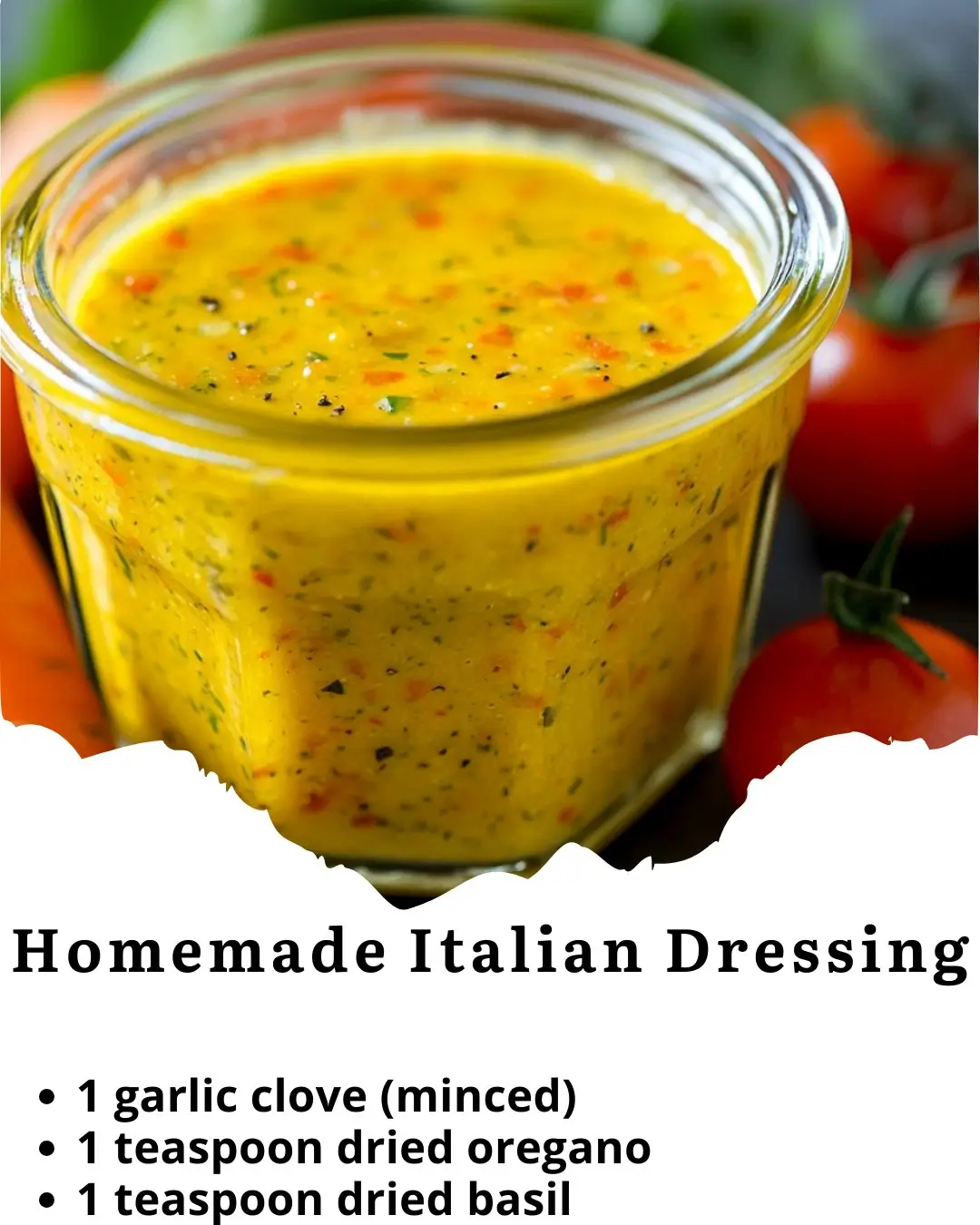Introduction to Homemade Italian Dressing
Homemade Italian dressing brings a burst of fresh and vibrant flavors to any salad, elevating simple ingredients into a delightful culinary experience. Creating your own dressing allows you to control the quality and balance of flavors, ensuring a perfect accompaniment to your favorite dishes. The combination of herbs, spices, and quality oils results in a versatile dressing that can also double as a marinade for meats and vegetables. Making Italian dressing at home is both easy and rewarding, offering a healthier alternative to store-bought versions laden with preservatives. Embracing this simple recipe can transform your meals and impress your guests with authentic, homemade taste.

Homemade Italian Dressing
- Total Time: 5 minutes
- Yield: 1 cup (approx. 8 servings) 1x
- Diet: Vegetarian
Description
A zesty and fresh Italian dressing made from a blend of olive oil, vinegar, herbs, and spices, perfect for salads or as a marinade for meats and vegetables.
Ingredients
1/2 cup olive oil
1/4 cup red wine vinegar
1 tablespoon lemon juice (freshly squeezed)
1 teaspoon Dijon mustard
1 garlic clove (minced)
1 teaspoon dried oregano
1 teaspoon dried basil
1/2 teaspoon dried thyme
1/2 teaspoon dried rosemary
1/4 teaspoon onion powder
1/4 teaspoon garlic powder
1/4 teaspoon sugar (optional)
Salt and black pepper to taste
Instructions
Combine Ingredients: In a medium-sized mixing bowl or a mason jar, combine the olive oil, red wine vinegar, and lemon juice.
Add Mustard and Spices: Add the Dijon mustard, minced garlic, oregano, basil, thyme, rosemary, onion powder, and garlic powder to the mixture. If using, add the sugar for a slightly sweet flavor.
Season: Season with salt and black pepper to taste.
Mix Well: Whisk the ingredients together until well combined, or if using a mason jar, seal and shake vigorously.
Taste and Adjust: Taste the dressing and adjust seasoning if necessary.
Notes
For a sweeter dressing, increase the honey or add a dash of sugar. You can also customize the herbs according to your taste, using fresh herbs for a more vibrant flavor.
- Prep Time: 5 minutes
- Cook Time: 0 minutes
- Category: Dressing, Marinade
- Method: Whisked
- Cuisine: Italian
Nutrition
- Calories: 90
- Sugar: 0g
- Sodium: 90mg
- Fat: 9g
- Carbohydrates: 1g
- Fiber: 0g
- Protein: 0g
Keywords: Italian salad dressing, DIY Italian dressing, homemade vinaigrette
FAQs
1. How long does homemade Italian dressing last?
Homemade Italian dressing can last up to a week in the refrigerator when stored in an airtight container.
2. Can I use this dressing as a marinade?
Yes, this dressing works wonderfully as a marinade for chicken, fish, or vegetables, adding flavor and moisture.
3. Can I make this dressing vegan?
To make it vegan, simply omit the honey or replace it with maple syrup or agave nectar.
4. What other vinegars can I use?
You can substitute red wine vinegar with white wine vinegar, apple cider vinegar, or even balsamic vinegar for a different flavor profile.
5. How can I make the dressing thicker?
To thicken the dressing, you can add more Dijon mustard or a small amount of mayonnaise.
Preparing homemade Italian dressing provides an opportunity to experiment with different herbs and spices to suit your personal palate. Fresh ingredients like garlic and herbs impart a robust flavor that is often missing from commercially prepared dressings. Adjusting the acidity and sweetness levels allows you to create a dressing that perfectly complements the ingredients in your salad or marinade. The process is quick and requires minimal equipment, making it convenient for everyday meal preparations. Once you try making your own Italian dressing, you’ll appreciate the freshness and customization it brings to your dining table.
Understanding the components of a classic Italian dressing helps in creating a balanced and harmonious flavor profile. The interplay between acidic elements like vinegar and lemon juice with the richness of olive oil forms the base of this dressing. Incorporating a blend of dried and fresh herbs adds depth and complexity, while subtle additions like Dijon mustard and honey enhance the overall taste. Mastering this simple recipe empowers you to whip up delicious dressings on demand, ensuring your salads are never dull or monotonous. The versatility of homemade Italian dressing makes it a staple in any kitchen, ready to enhance a variety of dishes.
Crafting your own Italian dressing also offers health benefits by eliminating unnecessary additives and controlling the quality of ingredients used. Choosing high-quality extra-virgin olive oil provides healthy fats essential for a balanced diet, while fresh herbs contribute antioxidants and essential nutrients. Reducing or substituting sugar with natural sweeteners allows for a healthier dressing option without compromising on taste. Being mindful of sodium levels by adjusting the amount of added salt ensures that your dressing aligns with dietary preferences and needs. Embracing homemade dressings promotes healthier eating habits and enhances the enjoyment of fresh, wholesome foods.
Sharing homemade Italian dressing with friends and family can be a delightful way to showcase your culinary skills and love for fresh, flavorful food. Bottling your dressing in decorative containers makes for thoughtful and personalized gifts during gatherings and celebrations. Introducing others to the joys of homemade dressings can inspire healthier eating choices and appreciation for simple, homemade delights. Hosting meals featuring your signature dressing creates memorable dining experiences centered around fresh and delicious flavors. The simplicity and charm of homemade Italian dressing make it a beloved addition to any food lover’s repertoire.
Essential Ingredients for Authentic Flavor
Extra-virgin olive oil serves as the cornerstone of authentic Italian dressing, providing a rich and smooth base that carries the flavors of the other ingredients beautifully. Selecting a high-quality olive oil ensures a fruity and slightly peppery taste that enhances the overall profile of the dressing. The oil’s healthy monounsaturated fats not only contribute to the dressing’s luxurious texture but also offer various health benefits. Balancing the oil with the right proportion of acidic ingredients creates a harmonious and well-rounded flavor. Investing in good olive oil sets the foundation for a truly delicious and authentic homemade Italian dressing.
Vinegar plays a crucial role in adding acidity and brightness to Italian dressing, with options like red wine vinegar or white wine vinegar offering distinct flavor profiles. Red wine vinegar imparts a robust and tangy taste, complementing hearty salads and marinades, while white wine vinegar provides a lighter and more delicate acidity suitable for subtle flavors. Balsamic vinegar can also be used for a sweeter and richer depth, adding complexity to the dressing. Combining different types of vinegar allows for customization and experimentation to achieve your preferred level of tanginess and flavor intensity. The choice of vinegar significantly influences the character and versatility of your homemade dressing.
Aromatic herbs and spices infuse Italian dressing with its signature savory and earthy notes, creating a complex and satisfying taste experience. Dried herbs such as oregano, basil, and thyme are traditional choices that bring a depth of flavor reminiscent of classic Italian cuisine. Freshly minced garlic adds a pungent and robust element, enhancing the savory aspects of the dressing and providing additional health benefits. Incorporating red pepper flakes introduces a subtle heat that elevates the overall flavor without overpowering the other ingredients. Freshly ground black pepper and a pinch of salt round out the seasoning, ensuring a balanced and harmonious blend of flavors. Mastering the combination of these herbs and spices is key to achieving an authentic and delicious Italian dressing.
Emulsifiers like Dijon mustard play an important role in binding the oil and vinegar together, creating a smooth and cohesive dressing that clings beautifully to salad ingredients. The subtle sharpness and depth of flavor from the mustard also contribute to the overall taste, adding complexity and a slight zing that enhances the other components. A touch of sweetness from ingredients like honey or sugar balances the acidity and sharpness, rounding out the flavors and providing a pleasant finish. Adjusting the amounts of these emulsifiers and sweeteners allows for customization according to personal taste preferences and dietary requirements. Understanding the function of these ingredients helps in creating a perfectly balanced and stable dressing.
Fresh citrus juice, such as lemon juice, brings an additional layer of brightness and freshness to homemade Italian dressing, lifting the flavors and adding a zesty kick. The natural acidity of citrus complements the vinegar, while its unique flavor profile adds complexity and a refreshing quality to the dressing. Including freshly grated lemon zest can further enhance the citrus notes, providing a subtle aromatic element that delights the senses. The incorporation of citrus also contributes beneficial vitamins and antioxidants, enhancing the nutritional value of the dressing. Utilizing fresh citrus ingredients adds a vibrant and lively dimension to your homemade Italian dressing, making it even more appealing and flavorful.
Step-by-Step Preparation Guide
Begin by assembling all your ingredients and necessary tools, ensuring a smooth and efficient preparation process for your homemade Italian dressing. Gather high-quality extra-virgin olive oil, your choice of vinegar, fresh and dried herbs, spices, and any additional flavor enhancers you plan to use. Prepare measuring spoons, a whisk, and a medium-sized bowl or a mason jar with a tight-fitting lid for mixing and storing the dressing. Having everything ready and within reach simplifies the process and allows you to focus on achieving the perfect balance of flavors. Preparation and organization are key to creating a delicious and hassle-free dressing experience.
Start the mixing process by combining the acidic components, including vinegar and freshly squeezed lemon juice, in your chosen mixing container. Add the minced garlic, Dijon mustard, and any sweeteners like honey or sugar to the mixture, whisking thoroughly to blend these ingredients together. Incorporating the herbs and spices at this stage allows them to infuse into the acids, releasing their flavors more effectively and creating a cohesive base for the dressing. Ensuring that these elements are well combined sets the stage for a harmonious and balanced final product. Attention to detail during this step contributes significantly to the depth and complexity of your dressing’s flavor.
Slowly drizzle the extra-virgin olive oil into the mixture while continuously whisking to create a smooth and stable emulsion that holds the dressing together. Gradual incorporation of the oil ensures that it blends seamlessly with the acidic base, preventing separation and achieving a silky, cohesive texture. If using a mason jar, you can combine all the ingredients and shake vigorously until the dressing emulsifies and reaches the desired consistency. Continuously tasting and adjusting the seasoning during this process allows you to fine-tune the balance of flavors, ensuring the dressing meets your personal preferences. Mastering the emulsification technique results in a well-blended and appealing homemade Italian dressing.
Once the dressing is fully mixed and seasoned to your liking, allow it to rest for at least 15 minutes to enable the flavors to meld and develop further complexity. This resting period gives the herbs and spices time to infuse their aromas and tastes fully into the dressing, enhancing its overall profile and depth. For an even more intensified flavor, consider preparing the dressing several hours or a day in advance, storing it in the refrigerator until ready to use. Before serving, give the dressing a good stir or shake to re-emulsify and redistribute any settled ingredients. Patience during this step rewards you with a more robust and harmonious dressing that elevates any dish it accompanies.
Apply your freshly prepared Italian dressing generously over your chosen salad ingredients, tossing thoroughly to ensure even coating and distribution of flavors. The dressing’s vibrant and aromatic qualities enhance the natural tastes and textures of fresh vegetables, creating a satisfying and delicious salad experience. Beyond salads, use the dressing as a flavorful marinade for meats, seafood, or vegetables, infusing them with savory and zesty notes before grilling or roasting. Experimenting with different applications showcases the versatility of your homemade dressing and adds variety to your meals. Enjoying the fruits of your labor brings a sense of accomplishment and delight to your dining experiences.
Tips for Customizing Your Dressing
Experimenting with different types of oils allows you to customize the flavor and health profile of your Italian dressing to suit your preferences. Substituting part or all of the extra-virgin olive oil with alternatives like avocado oil or grapeseed oil introduces subtle variations in taste and nutritional benefits. Using flavored oils infused with herbs, garlic, or chili can add an extra layer of complexity and interest to your dressing. Adjusting the oil proportions also affects the dressing’s richness and mouthfeel, enabling you to create lighter or more decadent versions as desired. Exploring various oil options expands your culinary repertoire and keeps your salads exciting and diverse.
Varying the acidic components in your dressing opens up a world of flavor possibilities and allows for personalization based on your taste and the dishes you accompany. Trying different types of vinegar, such as apple cider vinegar, champagne vinegar, or sherry vinegar, introduces unique flavor notes and levels of acidity. Incorporating fruit juices like orange or grapefruit alongside or instead of lemon juice adds a subtle sweetness and fruity undertone that complements various salad ingredients. Balancing multiple acids creates depth and intrigue, enabling you to tailor your dressing to specific cuisines or meal themes. This creative exploration enhances your cooking skills and enjoyment of homemade dressings.
Incorporating additional flavor enhancers and aromatics can elevate your Italian dressing, making it more versatile and suited to a broader range of dishes. Adding finely chopped fresh herbs like parsley, dill, or chives introduces freshness and brightens the overall flavor profile. Including a pinch of red pepper flakes or a dash of hot sauce adds a subtle kick for those who enjoy a bit of heat in their dressings. Mixing in grated Parmesan or Romano cheese provides a savory and umami-rich dimension, enhancing the dressing’s richness and appeal. Customizing with these extras allows you to create signature dressings that reflect your culinary style and preferences.
Adjusting the sweetness and seasoning levels in your dressing ensures it complements your specific taste and dietary requirements. Reducing or eliminating added sugars caters to those seeking a less sweet or more health-conscious option, while alternative sweeteners like agave nectar or maple syrup offer distinct flavor profiles. Modifying the salt content allows for control over sodium intake and accommodates various health needs and flavor preferences. Incorporating freshly ground black pepper or experimenting with different spice blends adds complexity and caters to diverse palates. Fine-tuning these elements results in a personalized dressing that enhances your meals and aligns with your lifestyle.
Exploring different textures and consistencies in your Italian dressing adds variety and interest to your salads and dishes. Blending in ingredients like finely chopped sun-dried tomatoes or olives introduces a hearty and robust texture that complements more substantial salads or grain bowls. Adding a small amount of mayonnaise or Greek yogurt creates a creamier dressing, offering a luscious and indulgent mouthfeel ideal for certain recipes. Adjusting the ratio of oil to vinegar influences the thickness and viscosity, allowing you to create lighter or more coating dressings as desired. Playing with these textural elements enhances the sensory experience and enjoyment of your homemade dressings.
Serving Suggestions and Pairings
Drizzling your homemade Italian dressing over fresh green salads elevates the flavors and adds a delightful zest that enhances the natural crispness and taste of the vegetables. Combining a variety of greens like romaine, arugula, and spinach with colorful additions such as cherry tomatoes, cucumbers, and red onions creates a vibrant and nutritious dish. Adding protein elements like grilled chicken, shrimp, or chickpeas turns the salad into a satisfying and balanced meal perfect for lunch or a light dinner. Sprinkling toppings like croutons, nuts, or cheese complements the dressing and adds texture and richness. This classic pairing showcases the versatility and appeal of your homemade dressing.
Using your Italian dressing as a marinade transforms simple proteins and vegetables into flavorful and succulent dishes that delight the palate. Marinating chicken breasts, pork chops, or tofu in the dressing infuses them with savory and aromatic notes, resulting in tender and juicy outcomes when grilled, baked, or sautéed. Tossing vegetables like bell peppers, zucchini, and mushrooms in the dressing before roasting brings out their natural sweetness and adds a delicious, herb-infused glaze. Incorporating this marinade technique simplifies meal preparation while delivering restaurant-quality flavors in the comfort of your home. The adaptability of the dressing enhances a wide range of ingredients and cooking methods.
Incorporating your Italian dressing into pasta salads creates a refreshing and flavorful side dish perfect for picnics, barbecues, or casual gatherings. Combining cooked pasta with fresh vegetables, olives, mozzarella cheese, and a generous drizzle of dressing results in a harmonious blend of textures and tastes that appeals to diverse crowds. Adding proteins like salami, grilled chicken, or beans turns the pasta salad into a hearty and satisfying main course suitable for any occasion. Adjusting the amount of dressing allows you to achieve the desired level of flavor and moistness, ensuring a delightful eating experience. This versatile dish demonstrates the dressing’s ability to enhance and unify various ingredients.
Enhancing sandwiches and wraps with your homemade Italian dressing adds moisture and a burst of flavor that takes these simple meals to the next level. Drizzling the dressing over deli meats, cheeses, and fresh vegetables inside a sandwich or wrap introduces a tangy and herbaceous element that complements and balances the other ingredients. Using the dressing as a spread or dipping sauce for breadsticks and artisan breads offers a delicious alternative to traditional condiments, adding sophistication and depth to your snack or appetizer. This application showcases the dressing’s versatility and ability to elevate everyday meals with minimal effort.
Pairing your Italian dressing with grilled or roasted vegetables creates flavorful and nutritious side dishes that complement a variety of main courses. Tossing vegetables like asparagus, eggplant, or Brussels sprouts in the dressing before cooking infuses them with savory and aromatic notes, enhancing their natural flavors and creating a delicious caramelized finish. Serving these dressed vegetables alongside grilled meats, fish, or hearty grains completes a balanced and satisfying meal that appeals to all tastes. Incorporating the dressing into vegetable preparations encourages healthier eating habits by making nutritious foods more enticing and flavorful.
Conclusion
Homemade Italian dressing offers a burst of fresh and vibrant flavors that elevate any salad or dish it accompanies. By using high-quality ingredients and customizing the herbs and seasonings to your liking, you can create a dressing that is both delicious and versatile. Whether used to dress a crisp salad or marinate meats and vegetables, this homemade Italian dressing is a healthier and more flavorful alternative to store-bought versions. Making your own dressing allows you to enjoy the authentic taste of Italian cuisine right at home, with the satisfaction of knowing exactly what’s in your food.





